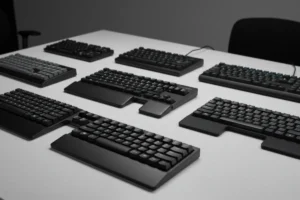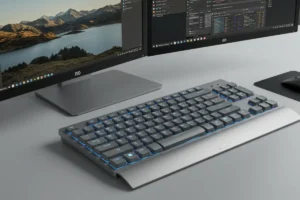Having a dual monitor setup is one of the most effective ways to boost productivity, streamline your workflow, and make multitasking feel effortless. But many people overlook a crucial part of this equation: the keyboard setup.
A properly positioned keyboard can make or break your productivity, prevent wrist pain, and help you transition smoothly between screens.
In this article, I’ll walk you through, step-by-step, how to set up your keyboard perfectly for a dual monitor workstation. We’ll explore ergonomic positioning, keyboard types, essential accessories, and pro tips to enhance your experience.
Don’t worry, this guide is written in a super simple and fun way — even a 12-year-old can understand!
Also, throughout this article, I’ll link you to other helpful resources on our blog, Keyboards Technology, and authoritative sites like Wikipedia to provide you with the most comprehensive reading experience possible!
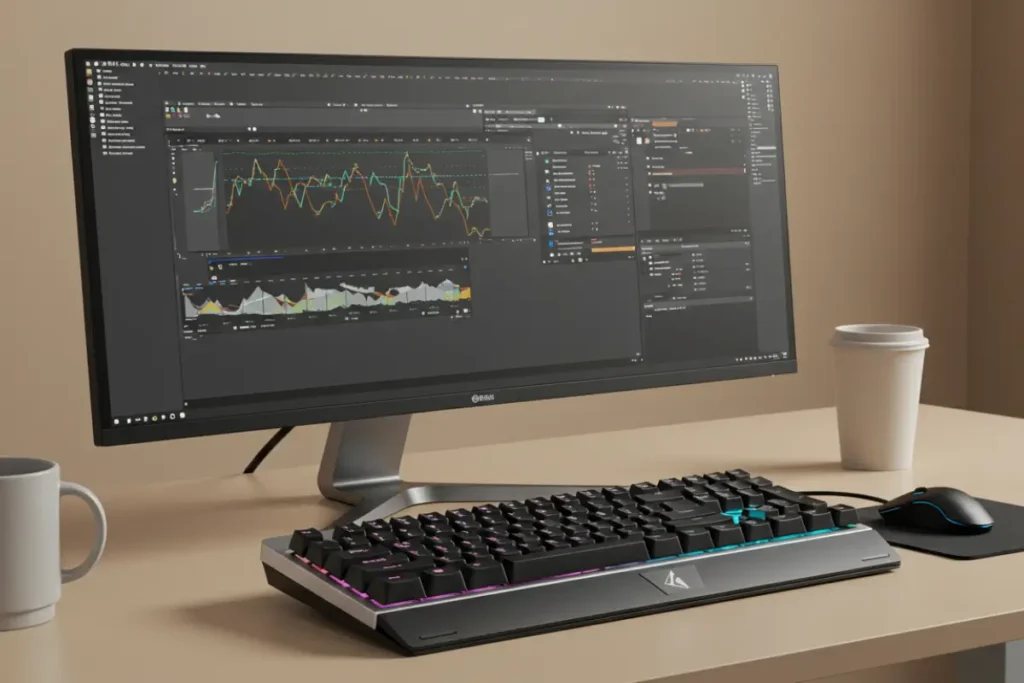
Why Your Keyboard Setup Matters for Dual Monitor Use
The way you position and configure your keyboard when using two monitors is essential for maintaining comfort and productivity. When done incorrectly, you may suffer from neck strain, wrist fatigue, or even long-term musculoskeletal issues like RSI (Repetitive Strain Injury).
When your monitors are side by side, many users tend to twist their bodies or extend their arms unnaturally to type, especially when moving their focus from one screen to another. This creates unnecessary physical tension and reduces your efficiency.
A well-optimized keyboard setup ensures your hands naturally rest in front of your body, while allowing your eyes and neck to switch between screens effortlessly.
This not only improves your posture but also minimizes distractions, so you can focus on your tasks — whether that’s coding, gaming, writing, or content creation.
Additionally, with remote work and hybrid offices becoming the norm, having a perfect home setup is not a luxury anymore, but a necessity. You deserve to work comfortably and productively, and your keyboard plays a central role in that!
If you’re interested in how keyboards influence productivity in general, don’t miss our in-depth article: The Influence of Keyboards on Productivity: Myth or Reality?
Step-by-Step Guide to Setting Up Your Keyboard for Dual Monitor Productivity
Setting up your keyboard correctly is simpler than it seems, but it requires careful consideration of your posture, monitor placement, and desk organization.
✅ Step 1: Position Your Monitors Correctly
Your monitors should be placed at an angle that reflects how often you use each screen. If you use both equally, position them symmetrically with your keyboard centered between them.
If you use one as a primary display, place it directly in front of you with the secondary monitor at a slight angle.
This avoids unnecessary neck twisting and ensures that your keyboard remains aligned with your natural typing position.
Pro Tip: Use monitor arms to adjust height and distance easily — keeping the top of your monitor at or slightly below eye level.
Example: If you’re a coder who writes code on one screen and tests on another, keeping your keyboard centered prevents awkward twisting.
Want to learn about ergonomic keyboards that can further enhance comfort? Check out: How Ergonomic Keyboards Can Prevent Wrist Pain
✅ Step 2: Choose the Right Keyboard
The type of keyboard you use can significantly impact your comfort and efficiency. Here are some keyboard types that work exceptionally well with dual monitor setups:
- Split Ergonomic Keyboards: These allow you to position each half independently, ideal for reducing strain when working with multiple monitors.
- Compact Keyboards: If desk space is limited, a 60% or 75% keyboard gives you more room to position your mouse and other accessories comfortably.
- Mechanical Keyboards: Preferred by many for their tactile feedback and durability, mechanical keyboards are great for those who type extensively across dual screens.
For inspiration, explore our article: 10 Compact Keyboards for Minimalist Setups — it’s packed with great options!
✅ Step 3: Adjust Your Keyboard Position
Place your keyboard so that it is directly in front of your primary monitor or between both monitors if you use them equally. Your elbows should be at a 90-degree angle, and your wrists should remain straight while typing.
Keep your keyboard at a comfortable distance — not too close that you hunch over, and not too far that you extend your arms uncomfortably.
Optional Accessories:
- Keyboard trays for height adjustment
- Wrist rests for additional support
- Tiltable stands for better ergonomics
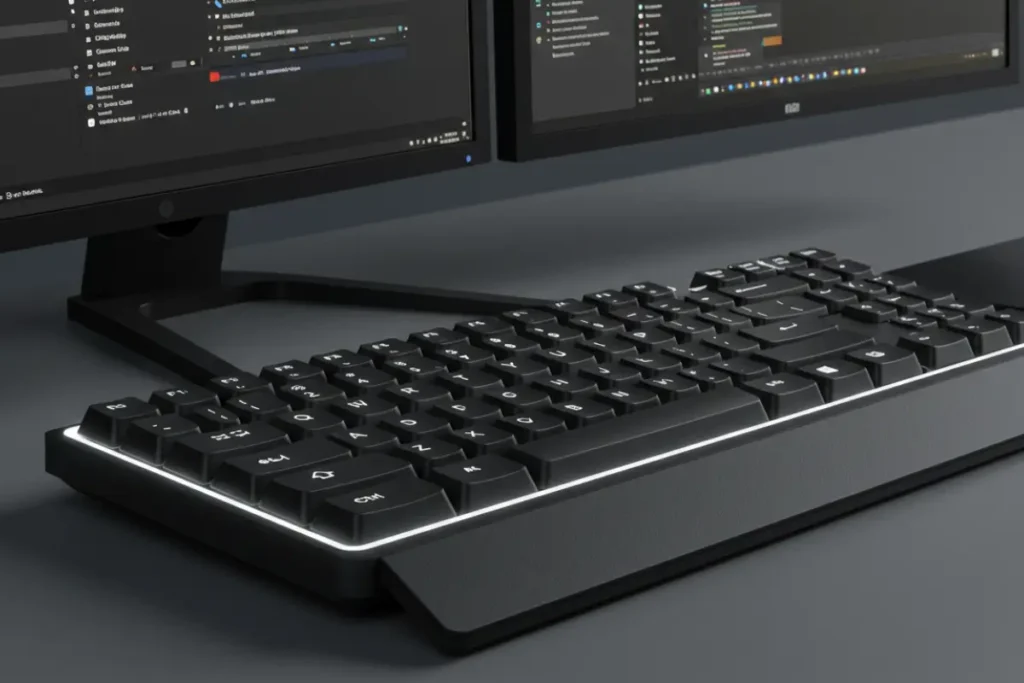
✅ Step 4: Optimize Your Desk Setup
Beyond the keyboard itself, your entire desk organization affects your typing efficiency when using dual monitors.
Make sure to:
- Keep frequently used items within arm’s reach
- Use a mouse pad that complements your keyboard’s placement
- Ensure your chair height allows for a natural wrist position
If possible, consider cable management solutions to prevent clutter and create a visually appealing workspace.
For more tips on customizing keyboards for different needs, read: How to Choose the Best Keyboard for Your Needs: Work, Gaming, or Productivity
Essential Accessories for Dual Monitor Keyboard Setups
Adding the right accessories can dramatically improve your comfort and productivity when using a dual monitor setup. Here’s a detailed list of what you might need:
- Monitor arms for adjustable positioning
- Keyboard wrist rests to prevent strain
- Desk mats for an organized workspace
- Cable management clips to reduce clutter
- Ergonomic chairs that support proper posture
- Blue light filters for your monitors to reduce eye strain
Each accessory plays a key role in creating a productive and comfortable environment for extended working or gaming sessions.
For more insights on keyboards built for specific tasks, explore: The Best Keyboards for Different Professions: Writers, Designers, Coders
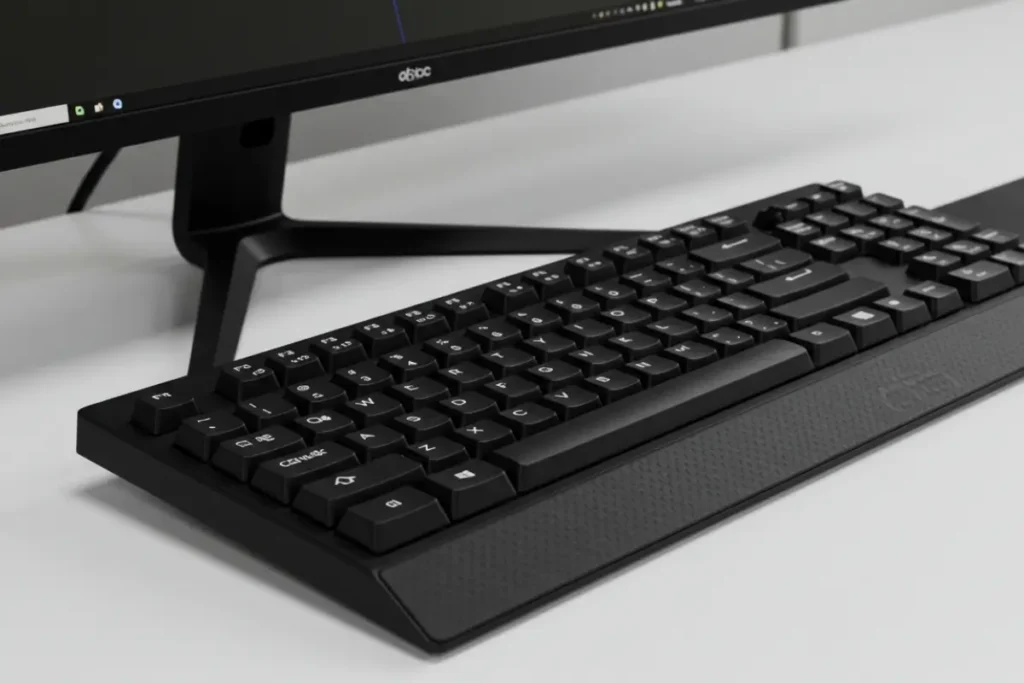
Common Mistakes to Avoid When Setting Up Your Keyboard
Many people make simple mistakes that can lead to discomfort and reduced productivity. Avoid these pitfalls:
❌ Placing the keyboard too close or too far — this can cause wrist or shoulder strain.
❌ Tilting the keyboard excessively — a negative tilt is usually best to maintain wrist neutrality.
❌ Ignoring monitor alignment — always ensure your monitors are aligned with your natural gaze.
❌ Neglecting ergonomics — comfort should always come before aesthetics.
For those interested in deeper ergonomic studies, here’s a helpful resource from OSHA.
Benefits of an Optimized Keyboard Setup for Dual Monitors
Implementing these tips doesn’t just prevent discomfort — it can significantly enhance your workflow. Here are the benefits:
✅ Improved posture and comfort
✅ Enhanced multitasking efficiency
✅ Reduced risk of repetitive strain injuries
✅ More organized and aesthetic workspace
And if you’re curious about how different keyboards affect your overall typing experience, check out: The Psychology of Typing: Why We Prefer Certain Keyboards
See More
- The History of Mechanical Keyboards in Esports
- The Best Keyboards for One-Handed Typing
- How to Set Up a Keyboard for Dual Monitor Productivity
Conclusion: Ready to Optimize Your Dual Monitor Setup?
Setting up your keyboard properly for a dual monitor workstation is one of the best investments you can make for your health and productivity. With the right position, accessories, and awareness of ergonomics, you can turn your workspace into a haven of efficiency and comfort.
If you liked this article, don’t forget to share it with your friends or colleagues who might benefit from improving their setups too! 😊
Also, be sure to check out more articles on our blog: Keyboards Technology — we cover everything from the future of foldable keyboards to the best keyboards for gaming setups.
For additional reading on monitor ergonomics and dual setups, you can explore this helpful guide from Wirecutter: The Best Dual Monitor Setup.
Thanks for reading, and here’s to your most productive setup yet! 🚀

